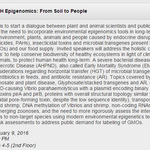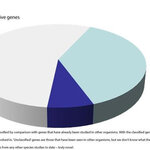The most desirable cotton is distinguished by having extra-long staple fibers (Egyptian, Pima) and such cotton commands a price premium. But as the cotton moves around the world, and through the fabric value chain, there is the potential for it to be diluted with or fraudulently replaced with lower price, lower quality materials.
Clothing manufacturers like to make quality-related or sourcing claims, but the closer an item gets to the retail shelf, the more difficult it is to certify that the garment is really made from the type of cotton they intended. A company based on Long Island called…
Genetics & Molecular Biology

Hijacking a Conference's Credibility
Back in November I received an email from Dr. Alison Van
Eenennaam. We both were planning to
attend the Plant-Animal Genome (PAG) Conference in San Diego in January. She pointed out one session in particular—a
session called ONE HEALTH Epigenomics from Soil to People. Here’s the
schedule for the session. Red flags
anyone?
You can see from the session that the presentations were an
odd mix. The session was coordinated by Acacia Alciar-Warren, a veterinarian with a molecular biology background in shrimp relatedness. Most…

Scientists have developed a new approach that could eventually be used to treat Duchenne muscular dystrophy, using CRISPR/Cas9 to correct genetic mutations that cause the disease.
CRISPR/Cas9 is a naturally occurring reaction that bacteria use to fight viruses. In 2012, scientists discovered they could adapt the process to make cuts in specific human DNA sequences. One part of the CRISPR/Cas9 system acts like a navigation system and can be programmed to seek out a specific part of the genetic code — a mutation, for example. The second part of the system can cut mutations out of the…

A genome-wide association study has identified genetic variants associated with being a morning person. The authors identified 15 locations in DNA (loci) associated with "morningness."
Morningness - being a morning person - is governed by differences in circadian rhythm, which have previously been linked to medically relevant traits such as sleep, obesity and depression.
"In this study we set out to discover more about an individual's preference toward early rising and were able to identify the genetic associations with "morningness" as well as ties to lifestyle patterns and other traits,"…

Fat is back, at least in some sense. It has just been replaced with polyunsaturated fats in the minds of nutritionists.
Studies on low-fat, high-carbohydrate diets and the recently popular fad called the Mediterranean diet have shown similar results in weight loss but are mixed when it comes to cholesterol, mostly because nutritional epidemiology relies on people remembering what they ate. To try and augment those, studies are done with animals, and they can provide some guidance but are often misused (what food hasn't been found to be a carcinogen in rats by now?). Still, that is…

Consider the engineering marvel that is your foot. Be it hairy or homely, without its solid support you'd be hard-pressed to walk or jump normally.
Now, researchers at the Stanford University School of Medicine and the HudsonAlpha Institute for Biotechnology in Huntsville, Alabama, have identified a change in gene expression between humans and primates that may have helped give us this edge when it comes to walking upright. And they did it by studying a tiny fish called the threespine stickleback that has evolved radically different skeletal structures to match environments around the world…

Researchers have taken what they hope will be the first step toward preventing and reversing age-related stem cell dysfunction and metabolic disease, including diabetes, which affects 12.2 million Americans age 60 and older, according to the National Council on Aging.
Researchers from the Mayo Clinic Center on Aging found that human senescent fat cells release a protein called activin A that impairs the function of fat tissue stem cells and fat tissue. They discovered an activin A increase in the blood and fat tissue.
Treatment with Janus kinase (JAK) inhibitor drugs in aged mice, equivalent…

Euglena gracilis, the single cell algae which inhabits most garden ponds, has a whole host of new, unclassified genes which can make new forms of carbohydrates and natural products. Euglena creates many well-known, valuable natural products including vitamins, essential amino acids and a sugar polymer which may have anti-HIV effects.
The genetic information in what we think of as simple algae is in fact enormous, which complicates definition of what these organism are capable of and has prompted the science community to largely focus of simpler microorganisms (bacteria, fungi, viruses…

New analysis examines the possibility of using in vitro gametogenesis (IVG) for human reproduction. IVG derives gametes from induced pluripotent stem cells (capable of giving rise to several different cell types) or human embryonic stem cells.
It's not ready for human procreation but it's a good idea to start discussing the implications in case it ever is, according to a study in the Journal of Law and the Biosciences.
Using a relational autonomy framework, Professor Sonia Suter of George Washington University analysed the potential benefits and harms of IVG, which depend on the…

Researchers say they have found the strongest evidence to date that human pluripotent stem cells -- cells that can give rise to all tissues of the body -- will develop normally once transplanted into an embryo.
Pluripotent stem cells for use in regenerative medicine or biomedical research come from two sources: embryonic stem cells, derived from fertilized egg cells; and induced pluripotent stem cells, where skin cells are 'reset' to their original form. The promise (bordering on hype in the case of human embryonic stem cells, with promises a decade ago of curing Alzheimer's if they just got…
